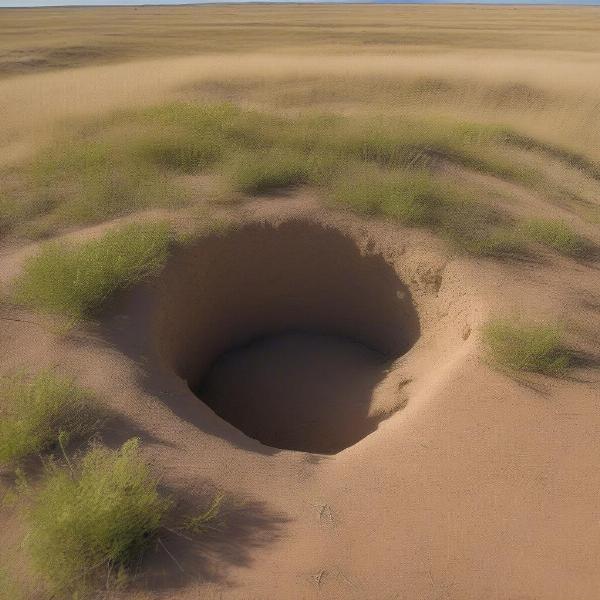Prairie dogs are a common sight in the grasslands of New Mexico, and their presence is a vital part of the ecosystem. These highly social animals are known for their complex burrows, constant chatter, and playful interactions. This guide explores the fascinating world of prairie dogs in New Mexico, covering their habitat, behavior, and the importance of conservation efforts.
Understanding Prairie Dog Behavior and Social Structure
Prairie dogs are highly social animals, living in complex family groups called coteries. A coterie typically consists of a breeding male, one or two females, and their offspring. These tight-knit groups exhibit intricate communication through various vocalizations, including barks, chirps, and whistles, which serve to alert others to potential dangers, identify individuals, and maintain social bonds. Their social interactions, from playful wrestling to cooperative grooming, contribute to the cohesion of the coterie and the overall health of the prairie dog town.
Prairie Dog Habitat and Distribution in New Mexico
New Mexico provides an ideal habitat for several prairie dog species, including the black-tailed prairie dog and the Gunnison’s prairie dog. They prefer shortgrass prairies, mesas, and valleys where the soil is suitable for burrowing. Their extensive burrow systems, often covering acres, provide shelter from predators, regulate temperature, and play a crucial role in soil aeration and nutrient cycling. The distribution of prairie dogs in New Mexico varies depending on the species, with some concentrated in specific regions and others more widespread across the state.
 Prairie dog burrow entrance in New Mexico landscape
Prairie dog burrow entrance in New Mexico landscape
The Importance of Prairie Dog Conservation
Prairie dogs are considered a keystone species in their ecosystem, meaning their presence is essential for the survival of many other plants and animals. Their burrows provide shelter for other species, their grazing habits influence plant diversity, and they serve as a crucial food source for predators like ferrets, foxes, and birds of prey. Unfortunately, prairie dog populations have declined significantly due to habitat loss, disease, and human persecution. Conservation efforts, including habitat restoration and disease management, are crucial to protecting these vital components of the New Mexico grassland ecosystem.
Threats to Prairie Dog Populations
Several factors threaten prairie dog populations in New Mexico. Habitat loss due to agriculture and urban development is a major concern. Sylvatic plague, a disease transmitted by fleas, can decimate prairie dog colonies. Human activities, such as poisoning and shooting, also contribute to their decline. Understanding these threats is essential for developing effective conservation strategies.
What is the Role of Prairie Dogs in the Ecosystem?
Prairie dogs play a crucial role in maintaining the health and biodiversity of grassland ecosystems. Their burrows aerate the soil, improving water infiltration and promoting plant growth. Their grazing helps to maintain a diverse mix of plant species. Their presence also provides essential prey for a variety of predators, contributing to the balance of the food web.
Are Prairie Dogs Endangered in New Mexico?
While not officially listed as endangered in New Mexico, some prairie dog species, such as the Gunnison’s prairie dog, are considered a species of concern due to their declining populations. Conservation efforts are ongoing to protect their habitat and mitigate threats to their survival.
How Can I Help with Prairie Dog Conservation?
Supporting organizations dedicated to prairie dog conservation is a great way to help. Educating yourself and others about their importance in the ecosystem can raise awareness and encourage responsible land management practices. Advocating for policies that protect prairie dog habitat is also crucial for their long-term survival.
FAQ
-
What do prairie dogs eat? Prairie dogs primarily eat grasses, forbs, and seeds.
-
How long do prairie dogs live? In the wild, prairie dogs typically live 3-5 years.
-
Are prairie dogs rodents? Yes, prairie dogs belong to the squirrel family and are classified as rodents.
-
What are prairie dog predators? Prairie dogs are preyed upon by a variety of animals, including coyotes, foxes, badgers, eagles, hawks, and snakes.
-
Do prairie dogs hibernate? Some prairie dog species, such as the black-tailed prairie dog, enter a period of reduced activity during the winter, but they do not truly hibernate.
-
Why are prairie dogs considered a keystone species? Prairie dogs are considered a keystone species because their presence has a disproportionately large impact on their ecosystem, influencing the survival of many other species.
ILM Dog is a leading online resource for dog owners worldwide, offering expert advice on dog breeds, health, training, nutrition, grooming, and much more. We are dedicated to providing valuable, practical information to help you care for your canine companion. For further guidance on dog care or specific breed information, contact us via email at [email protected] or phone at +44 20-3965-8624. Learn more about us and explore our extensive resources at ILM Dog.